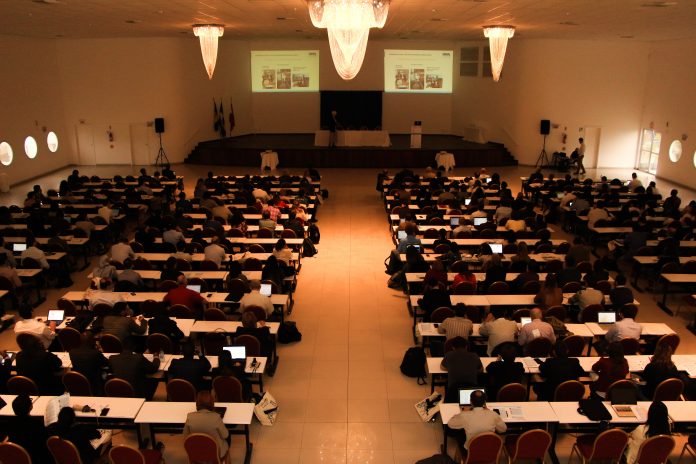IWA’s Leading Edge Technologies conference helps water innovators leapfrog the status quo.
By James Workman
Florianópolis, on Santa Catarina Island just off Brazil, is a magnet for curious minds. They come to discover pristine beaches, beautiful lagoons, breathtaking waterfalls–and ways to manipulate microbial communities, recover resources from effluent, and eradicate antibiotic-resistant bacteria.
Water binds all these interests as was clear when top water professionals and students of
pioneering science and innovative wastewater practices converged here on May 29 at the 14th Leading Edge Technologies (LET) conference, hosted by IWA and the Universidade Federal de Santa Catarina.
They shared new breakthroughs and debated old challenges to the wastewater sector, engaging in a wastewater “think tank”–a trusted forum to measure knowledge of, and advance tools in membranes and micro pollutants, processes and pathogens, local tweaks and global trends.
“But it is also the place to move and try new routes,” said IWA President Diane d’Arras. “Decentralised technologies could be the right solutions for green fields and developing countries, and green blue-infrastructure can be another way to combine and optimise hard technologies and soft ones.”
Too often, the water sector gets wrongly “accused of being risk averse or lagging behind other sectors,”
said IWA Senior Manager, Hong Li. But LET is “taking its inspiration from the rapid advancements made in areas such as computer science, genetics and microbial ecology, and brings together experts to find novel solutions and share thought leadership in water technologies.”
LET revealed our potential for innovation. For starters, advances in aerobic granular sludge can lower investment costs, reduce land area needed, slash energy needs and improve effluent quality. Microbial electrochemistry can generate a range of high-value outputs from
biological oxygen demand. Membrane biofilm processes can deliver gaseous substrates to bacteria.
“I was surprised by the rapid pace at which science is evolving,” said Pedro Alvarez of Rice University, “developing advanced materials such as multifunctional sorbents, catalysts and membranes that can help us provide more reliable and more affordable access to clean water.”
Each new tool is exciting. But real disruption may occur at the systems level. Modular water treatment, smart sensor networks, and complex modelling open up profound
opportunities. “More distributed treatment and reuse facilities can now match water quality to the intended use, as fit-for-purpose treatment,” said Alvarez. “Such facilities could be integrated into an existing urban water network at locations closer to the end users, to reduce the distance and energy requirements to transport water. Water supply costs would also be reduced by avoiding over-treatment of water intended for non-potable use to potable standards.”
With tariffs and subsidies embedded in water’s natural monopoly, few could entirely
separate public regulation from private innovation. “The best driver is economic,” said Bruce Rittmann, Director of the Biodesign Swette Center for Environmental Biotechnology
at Arizona State University. But “a fossil carbon tax would very strongly improve the economic case for technologies that generate energy instead of consuming energy.”
Many shared a consensus that fresh water is also undervalued, so market forces needed nudging. “Policy makers should consider that the price of water might provide incentives or disincentives for technological innovation to enable fit-for-purpose water treatment and reuse,” said Alvarez.
Yet some felt policy discouraged creativity, or allowed innovators to blame failure on government instead of pushing themselves further. “True leading edge technology emerges independent of laws and regulations,” said Mark van Loosdrecht, a professor at Delft University of Technology. “It arises from observation and curiosity. And most of the drive comes from enthusiastic individuals not from organisations.”
Participants observed significant cultural difference and regional variation. Driven by necessity, China demonstrates the fastest technological innovation and development of advanced materials. Europe is strong at adopting and implementing new proven echnologies. The US provides intellectual leadership through academic research, but suffers institutional inertia due to risk aversion and commercial isolation. Latin America lags now, largely due to the language barrier, but is quietly catching up, especially in environmental biotechnology.
Florianópolis’ beauty did not hide the rising risks of human pressure on its natural beaches, lagoons and waterfalls–or the world’s. Failure to achieve water safety and security would put “a catastrophic burden on society and a decimating limitation on human capacity,” said Alvarez.
LET also drove home how much of the developing world still lacks basic sanitation and treatment. This gap between rich and poor nations is a crisis, but also an opportunity to establish a baseline that “should be and can be different from what we do in most of the developed world,” said Rittman. “It can emphasise resource recovery and address emerging contaminants.”
Indeed, much as Wi-Fi and the mobile phone displaced traditional fixed cable and landline communications, LET showed how innovative toolsand modular approaches can potentially leapfrog the older technological systems now in place.
Perhaps that’s why scientists, practitioners and students came to Florianópolis in the first place.
Each curious mind sought to recover and redistribute water and wastewater’s most precious natural resource: human ingenuity.






